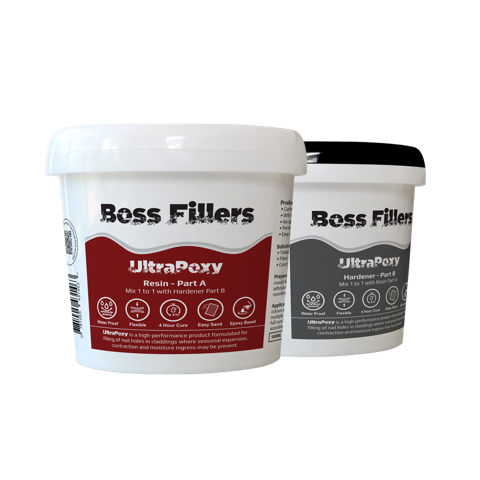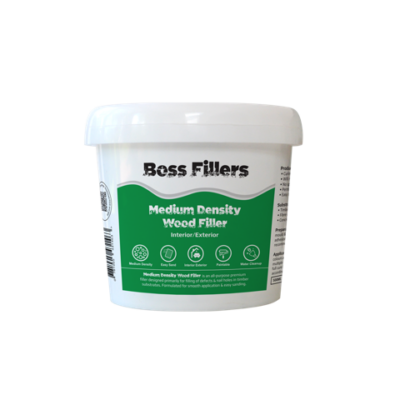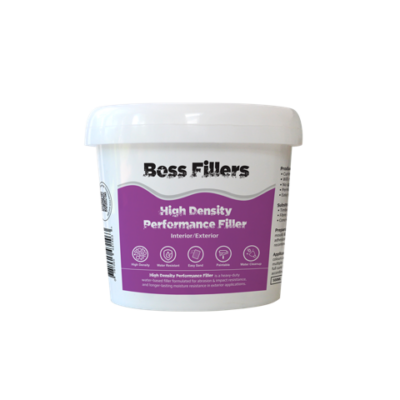Description
UltraPoxy is a high-performance product formulated for filling of nails and defects in timber cladding where seasonal expansion and contraction and moisture ingress may be present.
Quick facts:
- Working time ~ 25 mins at 20°.
- Curing time ~ 4 hours at 20°.
- Will not shrink, expands slightly as it cures.
- Micro-fibre reinforced.
- Mixing ratio 1 to 1.
- 100% moisture proof.
- Pre-gelled.
- High impact resistance.
- Permanently flexible.
- Easy sanding.
- 1 litre kit – 500ml hardener & 500ml resin.
Uses:
UltraPoxy has been specifically designed for use with timber claddings and substrates. Can be also used with a variety of other substrates including fibre cement, plastics, fibreglass, and metals.
Substrate Preparation:
- General guidelines for all substrate types:
- Ensure substrates and holes are clean and moisture free.
- Where friability of the substrate or egress of contaminants from the substrate is a concern, prime the holes prior to application of UltraPoxy with a specialized penetrating binding sealer.
- Prime textured surfaces prior to application of UltraPoxy to help minimize unintentional filling of texture around the holes.
- Timber, Particleboard & MDF: Where moisture ingress or efficacy of timber treatments is a concern pre-priming inside the holes with a specialized wood primer offers increased protection against timber decay, contaminant leaching, and corrosion of fixings.
- Fibre cement boards & panels: Where moisture ingress is a concern pre-priming inside the holes with a specialized penetrating sealer offers increased protection against permeability, contaminant leaching, and corrosion of fixings.
- Metals: Degrease surfaces if necessary. Use an abrasive cleaning method such as blasting, sanding, grinding, wire brushing, etching etc. to provide a clean bright surface.
- Fibreglass & GRP: Degrease and cross hatch sand with 60-100 grit paper. Polyester must be fully cured. Take special care to remove any surface wax. Remove sanding dust.
These guidelines are to be read in conjunction with and are in no way intended to replace or amend substrate manufacturers guidelines but are offered for the sole purpose of achieving optimal performance of UltraPoxy Filler. Online Paints accepts no responsibility for any failure resulting from any deviation from substrate manufacturers recommendations.
Application:
Measure out equal quantities by volume onto a board-knife and mix carefully and slowly until colours are uniformly blended. Do not overmix or undermix. Altering the mixing ratio will result in a slower cure and lower physical strengths. Apply immediately to the clean, prepared substrate. Use of a new, narrow-ended filling blade is recommended to avoid unnecessary spread of excess filler around the hole – remove excess filler, keep the spread area as small as possible, avoid filling any substrate texture. Wait for full cure before sanding.
Painting:
After sanding check that any pre-applied primers have not been removed and reapply if necessary. Apply a quality paint system appropriate to the substrate as per the paint manufacturers specifications.
Limitations and Recommendations:
- UltraPoxy does not behave similarly to polyester fillers like standard builders’ bog. It requires a minimum volume, temperature, and time period to reach full cure before sanding. Allow extra time to reach full cure in holes smaller than 3-4mm in diameter and depth. A minimum volume is required to self-generate enough heat to complete the chemical curing process within a reasonable time. As a basic rule, a standard jolt head nail punched to a depth of 4mm will have a high enough volume to reach full cure at 20° within a 4-hour time frame. Hotter days and higher volumes reduce cure time, colder days and lower volumes extend cure time. Application under 6 degrees is not recommended.
- Substrate temperature must be considered. Even when the atmosphere is warm, the substrate may remain cold, particularly in shaded areas. Cold substrates will extend cure time or may halt it altogether.
- Over-mixing or under-mixing will affect performance. Mixing should be done slowly and deliberately until the two colours (A+B) are uniformly blended. Over-mixing will cause the filler to cure prematurely leaving insufficient time for application. Under-mixing will extend the cure time or possibly prevent cure altogether. Hurried haphazard mixing should be avoided.
- Mixing ratio must be accurate. A ratio of 50/50 is optimal. Inaccurate ratios will result in imperfect curing. Take care to measure the ratio as accurately as possible. Do not alter the ratio for any reason.
- Sanding prior to full cure may result in some expansion. Sanding prematurely is to be avoided. If the curing process is interrupted by a drop in temperature, it will restart when the temperature rises. Sanding generates heat and will restart the curing process resulting in further expansion of the product, requiring additional sanding to achieve a level surface. Wait until the temperature rises and do not sand until full cure has been achieved. Careful use of a heat gun may be helpful in slow-to-cure areas.
- May not be suitable for use with paint colours darker than LRV45%. Check the substrate manufacturers specification before deciding on colours. As a rule, colours darker than LRV45% are not recommended on timber substrates. Substrates painted with colours darker than the substrate’s recommended LRV limit may warp or expand, causing distortion or popping of the filler.
- Flashing of darker colours may occur when used with fibre cement substrates. If applying colours tinted from low opacity bases flashing can occur. Additional sealer coats may be necessary to ensure porosity of the substrate has been fully neutralized before applying topcoats.
Precautions:
- Do not store in direct sunlight or near other sources of heat.
- Ensure adequate ventilation and use a respirator and safety glasses when sanding. Do not breath sanding dust.
- Keep out of reach of children.
- Use disposable plastic gloves to avoid skin contamination.
- Rinse eyes with water and wash skin with soap and water.
Download PDS and SDS Part A – SDS Part B




